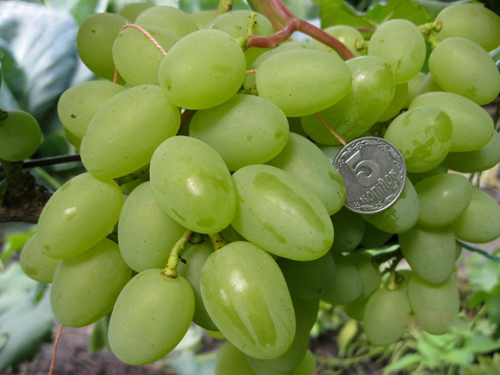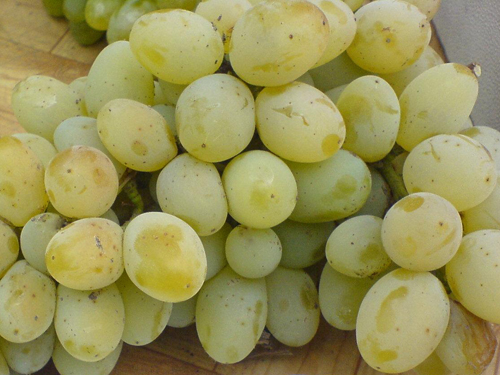Galahad grape variety
Galahad is a fairly new but very promising hybrid form of white table grapes. The first seedlings appeared on the market in 2007, and almost immediately caused a stir among amateur winegrowers who wanted to get the novelty at all costs. The reason for this increased interest was the outstanding characteristics of the variety, and in particular, its very early ripening period, large fruit size, high sugar accumulation and excellent berry taste, as well as complex resistance to fungal diseases.
A masterpiece with such remarkable properties was bred in Novocherkassk of the Rostov region by professional breeders from the All-Russian Research Institute of Viticulture and Winemaking named after V.I. ME AND. Potapenko. To do this, they first needed to cross two famous varieties - Mascot and Delight, and then pollinate the descendant of this pair with the pollen of Delight clam. The result of such complex manipulations was more than successful. In a short time, the new grape has gained a large army of admirers in various parts of our country and neighboring countries. And even though, so far, he has not achieved official recognition and inclusion in the state register of breeding achievements, the fantastic popularity at the amateur level convinces with all the evidence that Galahad has a bright future.

Agrobiological characteristics
The bushes are vigorous. The crown of a young shoot is shiny, whitish-green with a reddish tint of young leaves and the axis of the shoot. Formed typical leaves are rather large, rounded, dark green in color with light veins, five-lobed, strongly dissected. The surface of the leaf is smooth, matte, as if leathery. The profile of the leaf blade is almost flat, but often the edges of the blades can bend to the bottom. The upper lateral notches are deep, in most cases open, lyre-shaped or parallel-sided, with a pointed bottom. The lower cuts are noticeably shallower, also have parallel sides, or the shape of a recessed corner. The petiolate notch is vaulted, of medium width, with a sharp or flat bottom. The petioles are not too long, green, often with anthocyanin tones, sometimes quite intense. The teeth at the edges of the vine leaf are medium-sized, triangular, with slightly curved edges and blunt tops. The flowers of the variety are bisexual, and therefore the plants have almost no problems with pollination, the brushes grow well-formed, and the berries do not peas in them. Annual growth ripens well, not less than 80-90% of its length. At the same time, the color of the shoots changes to reddish brown. Autumn foliage color is yellow.
Ripe bunches of Galahad are very large, cylindrical-conical, moderately dense, weighing from 600 grams to more than a kilogram. Some of them overcome the one and a half kilogram milestone. The combs are grassy, but powerful, able to support the weight of massive brushes without any problems, green with reddish stripes. The berries are remarkably aligned, large, attractive oval in shape and appetizing amber-yellow color, sometimes with a brownish tan on the sunny side. Their average length is 27-28 mm, diameter - 21-22 mm, weight ranges from 10-12 grams. Despite the rather dense arrangement, the grapes do not crumple in bunches, do not deform and do not damage each other. The pulp of the fruit is juicy fleshy, has a very pleasant harmonious, neutral taste, does not differ in a bright varietal aroma. The sugar content of the juice is quite high, amounting, depending on the degree of ripeness of the grapes, 18-21 g / 100 ml, with a titratable acidity of 5-6 g / l. The skin of the berries is moderately dense, at the same time it protects the fruits well from all kinds of damage, and remains eaten without any problems. The bones are present, up to 3-4 in number, but they do not have a significant negative effect when eating.Tasting marks of well-ripened grapes reach 8.9 points.

The harvested crop of this variety is most often used for fresh consumption and sold. Large bunches of attractive color with sweet tasty berries are in high demand among buyers, which determines the significant popularity of the hybrid among farmers who cultivate the crop for commercial purposes. Galahad is especially appreciated by them for their readiness to harvest in the early stages, when the competition in the market is not yet great, and the prices for the "sun berry" are kept at a fairly high level, ensuring good profitability of its cultivation. Another important factor is the high transportability of the harvested fruits, which allows them to be transported over long distances, and thereby not be limited to only the local market. The keeping quality of the hybrid is sufficient to keep the grapes fresh for a long period under optimal conditions of temperature and humidity. On household plots, the bushes will also delight the owners with abundant harvests, the surplus of which can be processed with great success at home for juice, compotes, jams and marinades. In winter, these vitamin preparations will come in handy.
The variety deservedly belongs to the group of superearly varieties. Its growing season from the moment the buds open in the spring, until the bunches reach the conditions characteristic of removable maturity, is only 95-100 days. In the southern regions of industrial viticulture, harvesting can begin as early as the end of July. For ripening, not only a short period of time is required, but also very modest amounts of heat supply. By the time of the mass harvesting of grapes, the sum of active temperatures usually does not exceed 2100-2200 ° C, which clearly indicates the possibility of cultivating our hero even in the north, in by no means viticultural areas. So, a similar level of SAT, even in the coldest seasons, is typical for the latitude of Moscow, Kazan and Chelyabinsk, which means that the maturation of high-quality Galahad here is not something unattainable here. An additional bonus is the increased frost resistance of his vine. The viability of the aboveground part of the bushes up to -25 ° C allows them to be cultivated on a high bole in the south without any shelter, and in frost-prone regions it makes it possible to reduce the power of the insulation, and generally reduce labor costs when sheltering plants.

Productivity can also be attributed to the number of undoubted advantages of this variety. With a fruitfulness of shoots of 60-70%, a fruiting factor of 1.3-1.5, and very large bunches, the result of cultivation, expressed in the mass of the harvested crop, cannot but rejoice. Moreover, in order to prevent overloading of bushes, the number of shoots and bunches on them should even be limited, since uncontrolled fruiting threatens with a sharp decrease in the size and quality of bunches, a deterioration in the growth of annual shoots, an extension of the growing season and other negative consequences. With perennial excessive loads, plants greatly weaken, reducing frost resistance, which can cause them to die in winter. Without strain, with a sufficient level of agricultural technology, each adult Galahad bush is capable of producing 15-20 kg of grapes per year. Only young plants entering fruiting should be particularly severely limited in productivity.
During the ripening of the crop, it is not afraid of either rain, due to the resistance of the berries to cracking, or wasps, since the strong skin reliably protects the grapes from damage by insects. However, with a prolonged stay on the vine in a sultry summer, the fruits may begin to lose moisture and grow rainy. In addition, overripe berries of this variety, hanging in the sun, may have an unattractive rusty skin tone, which significantly reduces the presentation of the crop. Therefore, it is not recommended to overexpose the grape harvest on the bushes for more than two weeks; it is better to keep it in a cool, dry basement, already harvested.
Agrotechnical features
In cultivation, Galahad is not too difficult, and in order to obtain a decent harvest, the winegrower will only need basic knowledge of the culture and some specific features of the hybrid itself. So, our hero does not make excessive demands on the level of provision of the place of its growth with heat, moisture and mineral nutrition. All these parameters should be similar to those needed for other grape varieties, and the need for heat is even lower than that of many other varieties. The latter circumstance, however, does not mean that it can be planted anywhere. The lowlands, in which cold air accumulates, as well as the slopes of the northern expositions, are definitely not suitable for the vineyard.
Galahad cuttings root perfectly and quickly, so that its reproduction is not particularly difficult. However, the possibility of own-rooted culture is relevant only for winegrowers whose plots are located in regions free from phylloxera root. Where the soil is infected with a dangerous pest, it will be necessary to use seedlings grafted onto phylloxera-resistant rootstocks. For powerful, potentially large plants, the feeding area must be adequate. In this case, it is recommended to allocate at least 4.5-5 square meters per bush. meters of land.
The need for warming the grape vine to protect it from frost is mainly due to the minimum winter temperatures in the area where the vineyard is located. This, in turn, determines the formation of the bush, which begins to be removed from the second, and sometimes from the first year after planting. In areas with mild winters, where there is no risk of lowering the thermometer below -25 ° C, the preferred option would be to cultivate the variety on a high stem, without shelter. In more severe conditions, it is worth forming the bushes according to standard-free schemes, in order to be able to remove the vine from the trellis without damage to warm it.
Depending on the strength of growth and the vital energy of the plants that have entered fruiting, during spring pruning, about 30-40 buds are left on them, shortening the fruit arrows to 6-8 eyes. The next step in load regulation is debris, during which sterile and weak shoots are removed. As a result, no more than 22-24 fruitful vines should remain on the bush, on which the number of inflorescences is also thinned out. In the final form, on each shoot of grapes, ideally, only one large cluster should remain.
Fighting fungal diseases will not be exhausting for the grower. Due to the high complex resistance of Galahad to pathogens, the variety can be grown environmentally friendly, carrying out only single preventive treatments with fungicides before and after flowering.
Harvesting is recommended without delay. To prevent the appearance of a rusty sunburn on the berries, the bunches of grapes do not lighten too much during ripening, and sometimes they are also additionally shaded.








